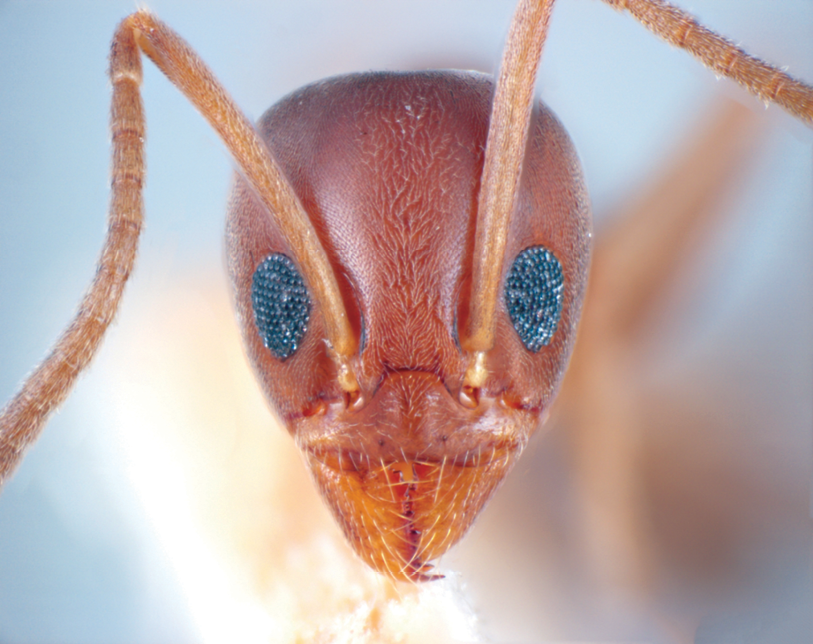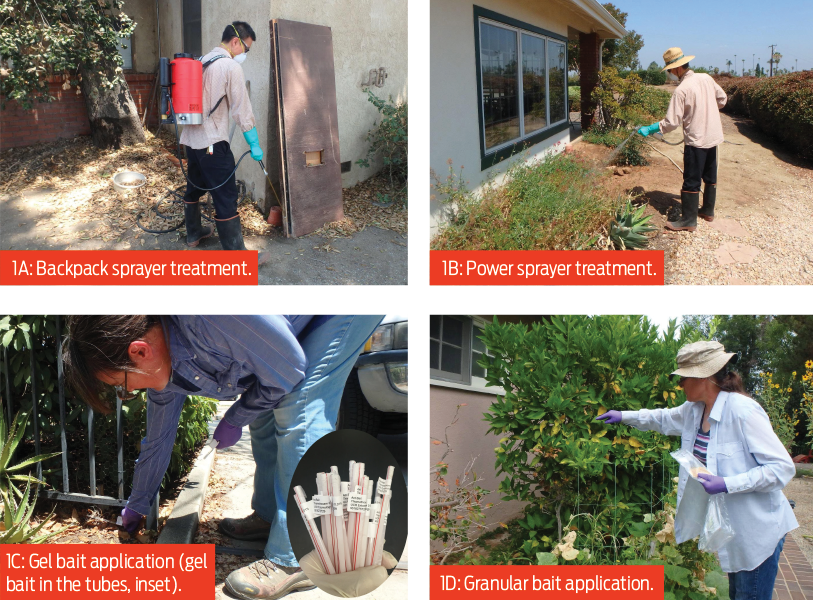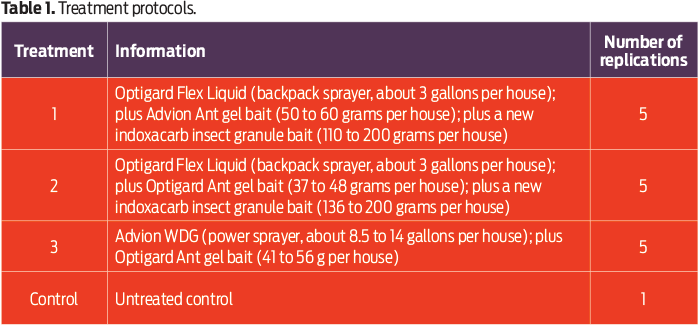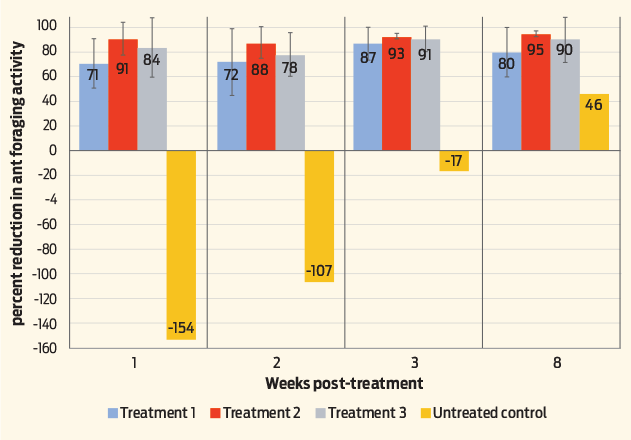Research out of UCR finds that even though Argentine ant control is labor intensive, the use of various formulations of perimeter sprays and baits may help reduce treatment times for PMPs.

Pest and Diseases Image Library, Bugwood.org
Editor’s note: This research was conducted by the University of California, Urban Entomology Laboratory. Syngenta provided financial support and necessary products for this study.
Argentine ants [Linepithema humile (Mayr)] are notoriously difficult to control. Native to South America, these ants have an unusual biology in that their colonies consist of several thousand workers and multiple queens. In most of their introduced range, workers from different colonies are not aggressive toward each other, allowing them to form a large supercolony, often linked by dense trails. Argentine ant nests are dispersed, but typically located in moist areas near a food source.
Found throughout the southern U.S. and California, Argentine ants can be very aggressive towards other small arthropods and insects, often impacting other ant species in the areas they colonize.
The colonies are mobile and relocate to more acceptable nesting locations whenever necessary. In some areas, they congregate in communal overwintering sites during colder months. Even if Argentine ants would not nest inside structures, the workers are very good at finding sweets within homes and quickly establishing foraging trails.
LIMITING PESTICIDE EXPOSURE. Insecticidal sprays are commonly used to control pestiferous ants around structures. Because the amount of insecticide the structural pest management industry (and the public) applies is frequently under scrutiny, it is important that pest management professionals (PMPs) do as much as possible to lower their environmental footprint. Utilizing various products with different modalities (active ingredients, formulations, etc.) in a strategic manner might be an important step in this effort. Among active ingredients currently available for ant control, thiamethoxam and indoxacarb are less commonly used by PMPs.
Thiamethoxam is a neonicotinoid insecticide. By mimicking the action of nicotine, it acts on the insect nervous system by binding to the acetylcholine receptor, triggering uncontrolled nerve activation and eventual paralysis. In California, thiamethoxam is not currently monitored in surface water samples. Indoxacarb is an oxadiazine insecticide, and it also acts on insect nervous systems by blocking the sodium channel. Indoxacarb was registered by U.S. EPA under its Reduced-Risk Pesticide Program (U.S. EPA 2000). In California, detection of indoxacarb in surface water samples is either extremely rare or almost non-existent (CA DPR, unpublished data).
Using Argentine ants as the target species, this study tested different combinations of spray and bait products containing thiamethoxam or indoxacarb in residential neighborhoods. Prior to the study, there had been relatively little information available about the effect of these active ingredients on Argentine ant control in the field. The findings from this formal field study might be useful for PMPs in developing their treatment protocols for ant management services.

GENERAL INFORMATION. Five residential houses (replicates) were used per treatment. Before the start of the experiment, houses were monitored for overall ant activity levels based on number of ant visits at monitoring tubes. Falcon plastic tubes (50 ml, Fisher Scientific) containing 20 ml of 25 percent sucrose solution were used as monitoring tubes. For each house, 10 monitoring tubes were placed along the perimeter. Each monitoring tube was covered with a plastic flower pot to protect it from direct sunlight and sprinkler irrigation.
After 24 hours, the tubes were capped, returned to the laboratory and weighed. The weight data were corrected for evaporative loss of the liquid during the 24-hour monitoring period. By calculating the difference between the initial weight and the adjusted weight of the remaining sucrose solution, we obtained the amount of sucrose solution consumed by the foraging ants over the 24-hour monitoring period. Based on this consumption amount, ant foraging activity level was estimated. One advantage of this type of monitoring is that it reflects an overall foraging activity of the ants over a relatively long period of time (i.e., 24 hours) rather than estimating the ant activity based on a snapshot observation (e.g., counting ant numbers on a trail for a fixed amount of time), in which the estimations could vary greatly depending upon the times of the day and ambient weather conditions.
The efficacy of the treatments were determined by comparing the ant activity levels between pre- and post-treatment monitoring sessions. Post-treatment foraging activity levels were standardized by dividing them by their own pre-treatment levels. The study was conducted between July 16 and Sept. 13, 2018. Argentine ants were consistently active during this time, and there were no dramatic shifts/changes in weather conditions (e.g., cold temperatures) that would impact the activity levels of Argentine ant populations in the field (see untreated control data below). We used one house as an untreated control. All products tested were supplied by Syngenta Crop Protection.



TREATMENT PROTOCOLS. Three different treatment protocols were developed by incorporating four different application methods: backpack sprayer, power sprayer, gel bait and granular bait.
Insecticidal sprays. The spray products tested were Advion WDG insecticide (indoxacarb) and Optigard Flex Liquid insecticide (thiamethoxam). The percentage of active ingredient in the finished spray was 0.05 percent for both products. A power sprayer was used to apply the Advion WDG and a backpack sprayer (Birchmeier Iris 4 Gallon Backpack Sprayer) was used to apply the Optigard Flex Liquid (see Figures 1A and 1B).
Insecticidal bait. The ant baits tested were 0.01 percent thiamethoxam gel bait (Optigard Ant gel bait insecticide), 0.22 percent indoxacarb (a new insect granule bait product; 0.75 pounds/1,000 square feet application rate) and 0.05 percent indoxacarb (Advion Ant gel bait insecticide) (see Table 1).
Application of gel bait. To maximize the availability and longevity of the gel baits, they were loaded into clear soft plastic tubes (19.5 cm by 0.5 cm diam) (Fig. 1C, inset). Using the tubes also helped prevent environmental contamination and the wasting of bait. The baits were injected into the tubes, leaving about 2 cm on the bottom and 3 cm on the top of the tube. The bottom end was heat sealed. The other end was covered with a piece of parafilm. The baits were placed into plastic cups with the heat-sealed ends on the bottom and stored in the refrigerator until placed out in the field. Each tube contained an average of 3.7 or 4.1 g of Optigard or Advion ant gel baits, respectively.
Each house was treated with 10-15 tubes containing the gel bait (total of 37-60 grams of gel bait per house) (Table 1). This amount of gel bait would be equivalent to the amount of gel bait from 1 or 2 gel bait syringes (30 grams per syringe). The tubes containing the baits were placed around the structure (Fig. 1C) on active ant trials whenever possible. Leaves, debris or small rocks were used to conceal the tubes.
Application of granular bait. A new indoxacarb insect granule bait product was used in this study. This product is pending EPA approval and will allow for reduced application rates, less dust during application, and the attraction of protein- and carbohydrate-feeding ants. We applied the granular bait to mulched flower beds or ground cover around structures (Fig. 1D). Approximately 0.15 pound (2.4 ounces) of granular bait was weighed and placed in a plastic bag, providing enough bait to treat 200 square feet. Depending upon the size of the areas that needed to be treated with the granular bait, the number of bags applied were different at each structure. On average, we used 2.5 ± 0.5 bags (mean ± SD) of the granular bait (0.37 pounds or 5.9 ounces) per house (Table 1).
RESULTS. What follows is a review of treatment efficacy and the amount of time spent performing treatments.
Treatment efficacy. Ant foraging activity levels are standardized by their own pre-treatment levels and results are summarized in Fig. 2. The data presented are the mean values from five replications (except the untreated control). Some findings from pre- and post-treatment monitoring sessions:
- At week one post-treatment, the treated houses showed mean reductions of ant numbers between 71 and 91 percent compared to their own pre-treatment data. During this period, the untreated control house had more than 2.5 times increase in ant activity.
- At week two post-treatment, the treated houses showed mean reductions of ant numbers between 72 and 88 percent compared to their own pre-treatment data. During this period, the untreated control house had more than 2 times increase in ant activity compared to its initial value.
- At week four post-treatment, the treated houses showed mean reductions of ant numbers between 87 and 93 percent compared to their own pre-treatment data. During this period, the untreated control house still had a substantial level of ant activity that was higher than its own initial value.
- At week eight post-treatment, the treated houses showed mean reductions of ant numbers between 80 and 95 percent compared to their own pre-treatment data. During this period, the untreated control house also started to show some reduction in ant activity level, being about 54 percent of its own initial value.
Time spent for treatment. Applying about 3 gallons of spray (Optigard Flex Liquid) around the house with a backpack sprayer took about 15 minutes. Finding the adequate locations for placing the baits took another 10 to 15 minutes. In general, these treatment protocols took three technicians about 10 to 20 minutes to complete each treatment (about 30 minutes between two technicians), one applying sprays and the other placing baits in proper locations (or assisting with the power spray operation). The use of a power sprayer (treatment 3) might save time, requiring about 13.2 minutes per house between three technicians (compare this to 16.6 minutes for treatment 1, where the backpack sprayer was used). See Table 2 for the time spent for each treatment.
DISCUSSION. All treatments were effective in providing a substantial control of Argentine ants at the houses over eight weeks during a period of peak Argentine ant activity. The results show that thiamethoxam and indoxacarb products are viable options for pest management professionals in managing Argentine ants. The relatively small standard deviations in the data of treatment 2 (thiamethoxam spray + thiamethoxam gel bait + indoxacarb granular bait; see Figure 2) suggests that it provided the most consistent data across the five treated houses.
Argentine ant control continues to be labor intensive. IPM approaches to managing this invasive pest include inspections, the use of multiple formulations and baiting techniques, all of which may be time consuming. Pest management professionals spend 20 to 25 minutes treating a typical residential account for ants, with either a monthly or bi-monthly treatment schedule. Our treatments described here were labor intensive, and a single technician could spend 30 to 60 minutes at each structure.
For example, a comprehensive treatment such as treatment 2 that provided more than 88 percent reductions in the Argentine ant activity for at least eight weeks might require about 45 minutes for a single technician. However, our treatment strategies might fit nicely into a program utilizing quarterly treatments. Furthermore, the use of a power sprayer or an electric backpack sprayer also might help reduce the time required for each treatment.
Choe, Greenberg, Campbell and Rust are with the Department of Entomology, University of California, Riverside. Paysen is with Syngenta Crop Protection, Greensboro, N.C.